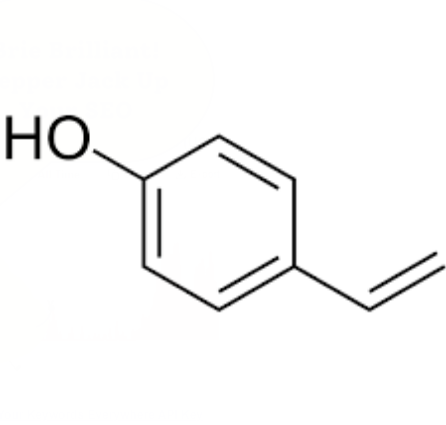The Future of 4-Vinylphenol: Trends and Predictions in the Industry
An Engaging Introduction
What if a single chemical compound could reshape multiple industries, from pharmaceuticals to materials science? Enter 4-Vinylphenol, also known as 4-Hydrostyrene (CAS No. 2628-17-3). This versatile compound is not merely a laboratory curiosity; it’s paving the way for groundbreaking innovations that could define the future of various sectors. With a molecular weight of 120.15 and an appearance as a white crystalline powder, 4-Vinylphenol is quickly gaining attention for its wide-ranging applications.

It serves as a key intermediate in the synthesis of ion exchange resins, photoresist polymers, and conductive materials, making it invaluable in both industrial and research settings. As industries seek more sustainable and efficient materials, the demand for 4-Vinylphenol is expected to rise. Its ability to contribute to eco-friendly solutions further enhances its appeal, solidifying its position as a game changer in the chemical landscape. The potential of 4-Vinylphenol is vast, promising exciting advancements in the years to come.
Current Trends in the Industry
As industries evolve, so do the materials that support them, leading to an escalating demand for high-performance materials across various sectors, including electronics, healthcare, and textiles. In this dynamic landscape, 4-Vinylphenol is uniquely positioned to meet these demands, serving as an essential intermediate in the synthesis of ion exchange resins, photoresist polymers, and other advanced materials. Its versatility makes it a crucial component in creating products that require durability and efficiency.
Moreover, the growing trend toward sustainable and multifunctional materials is driving significant interest in 4-Vinylphenol. As environmental concerns take center stage, industries are increasingly seeking eco-friendly alternatives that do not compromise on performance. 4-Vinylphenol fits this need perfectly, as it can be utilized to develop biodegradable polymers and other sustainable solutions. This dual capability not only positions 4-Vinylphenol as a key player in modern material science but also aligns with the global push for sustainability, making it an increasingly valuable compound for the future.
Future Predictions
Looking ahead, experts predict that the demand for 4-Vinylphenol will continue to rise significantly in the coming years. As technology progresses, its applications are expected to expand notably, particularly in the fields of conductive polymers and crosslinked fibers, which are essential for developing advanced materials used in electronics and textiles. Companies like UniVOOK Chemical are already leading the charge, producing high-quality industrial-grade and pharmaceutical-grade styrene derivatives that leverage the unique properties of 4-Vinylphenol.
The continuous improvement in polymerization techniques is set to enhance the versatility of this compound further, allowing for the creation of more complex and functional materials. This adaptability will make 4-Vinylphenol an indispensable component in cutting-edge innovations, meeting the diverse needs of various industries. As the push for more efficient, sustainable, and high-performance materials intensifies, the significance of 4-Vinylphenol will only grow, solidifying its position as a cornerstone of future advancements in material science.
The Role of 4-Vinylphenol in Modern Material Science
Importance in Polymer Chemistry
In the realm of polymer chemistry, 4-Vinylphenol serves as a bifunctional monomer, enabling the creation of copolymers with unique properties. Its ability to act as an initiator for polymerization processes means that it plays a critical role in the formation of complex polymer structures. These properties allow for the customization of materials, leading to applications that were previously unattainable.

Applications in Various Sectors
From pharmaceuticals to textiles, the applications of 4-Vinylphenol are extensive. In the pharmaceutical industry, it is utilized in the synthesis of various compounds, enhancing drug efficacy. In the textile sector, its properties contribute to the development of stronger and more durable fibers. Additionally, its role in the production of food additives demonstrates its versatility, as a 10% solution is often used to enhance flavors.
The Growing Importance of Safety
While 4-Vinylphenol presents numerous opportunities, safety considerations cannot be overlooked. As industries adopt this compound, it is crucial to consult the Material Safety Data Sheet (MSDS) for guidelines. UniVOOK Chemical emphasizes the importance of safety in its operations, providing comprehensive recommendations for the handling and storage of 4-Vinylphenol to mitigate risks.
4-Vinylphenol: Properties, Applications, and Safety Considerations
Key Properties
4-Vinylphenol boasts a density of 1.1±0.1 g/cm³ and a purity of 99% minimum, making it an ideal choice for industrial applications. These properties ensure that the compound remains stable under various conditions, contributing to its effectiveness in different formulations. Its white crystalline powder form also enhances its compatibility with other substances, making it easier to incorporate into various processes.
Diverse Applications
The versatility of 4-Vinylphenol cannot be overstated. As a key ingredient in ion exchange resins, it plays a significant role in water purification technologies. In the realm of electronics, it is essential for creating photoresist materials used in semiconductor manufacturing. Additionally, its use as a coupling agent in conductive polymers opens up new possibilities for the development of smart materials.
Health and Safety Measures
Understanding the health implications of using 4-Vinylphenol is critical for safe industrial practices. Companies like UniVOOK Chemical are committed to providing comprehensive safety documentation, ensuring that users are aware of the proper handling and storage guidelines. As the compound finds its way into more industries, ongoing education and awareness will be key to maintaining safety standards.
The Environmental Impact of 4-Vinylphenol: Myths and Facts
Debunking Common Myths
There are many misconceptions surrounding the environmental impact of chemical compounds like 4-Vinylphenol. Some believe that all industrial chemicals pose a significant threat to ecosystems. However, when used responsibly, 4-Vinylphenol can be part of sustainable practices in material science and manufacturing. Understanding the real impact is crucial for informed decision-making in the industry.
Environmental Benefits
One of the compelling arguments for 4-Vinylphenol is its potential to contribute to eco-friendly innovations. As a building block for advanced materials, it can be used to create biodegradable polymers and other sustainable products. This versatility allows industries to minimize their carbon footprint while still achieving high-performance results.

Future Environmental Considerations
As regulations around chemical usage tighten, industries will need to adapt. The future of 4-Vinylphenol will involve a greater emphasis on sustainability and environmental responsibility. UniVOOK Chemical is already leading the way by focusing on sustainable production methods and transparency regarding environmental impacts. This proactive approach is likely to set industry standards moving forward.
Conclusion
In conclusion, 4-Vinylphenol stands at the intersection of innovation and sustainability in modern material science. Its unique properties make it an invaluable asset across various industries, from pharmaceuticals to electronics and textiles. As companies increasingly recognize its potential, the role of 4-Vinylphenol is set to become even more significant, driving advancements and shaping the future of multiple sectors.
The compound not only facilitates the development of high-performance materials. It also promotes environmentally friendly practices by creating biodegradable options. With a strong focus on safety and environmental responsibility. Industries can utilize 4-vinylphenol to meet evolving regulatory standards while seeking sustainable solutions. Its diverse applications highlight its versatility and adaptability, making it a compound truly worth watching. As we move forward, the continued exploration and utilization of 4-Vinylphenol will likely unlock new possibilities, enhancing innovation and promoting sustainable practices in material science.
Access Our Product Catalog and More to Discover High-Performance Chemicals Tailored to Your Business Needs




